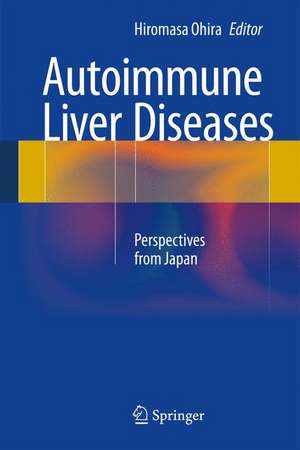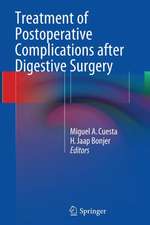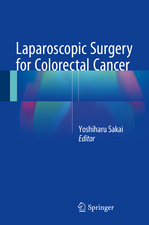Autoimmune Liver Diseases: Perspectives from Japan
Editat de Hiromasa Ohiraen Limba Engleză Hardback – 2 sep 2014
AIH in Japanese patients creates a unique disease population, as its clinical features are different from those of Western patients resulting from the different genetic background of the two patient populations. Also, mouse models of neonatal thymectomy-PD-1 knockout mice, clinical analyses of acute hepatitis-like manifestations, and research findings on IgG4-related autoimmune hepatitis have been reported in Japan and are included in this book. A disease-susceptibility gene specific to Japanese PBC patients has also recently been discovered. Because of the relatively homogeneous population of Japan, analyses conducted with Japanese PBC patients have yielded findings that are highly relevant to the pathogenesis of the disease.
Furthermore, new pathological staging criteria, anti-gp210 antibodies and the basis they provide for improved accuracy of prognosis, treatment with bezafibrate, and the outcomes of living-donor liver transplantation are also presented here. This volume therefore serves as a useful resource not only for hepatologists, but also for researchers, clinical residents, and medical students both in Japan and in other countries.
| Toate formatele și edițiile | Preț | Express |
|---|---|---|
| Paperback (1) | 779.92 lei 6-8 săpt. | |
| Springer – 22 sep 2016 | 779.92 lei 6-8 săpt. | |
| Hardback (1) | 1102.31 lei 6-8 săpt. | |
| Springer – 2 sep 2014 | 1102.31 lei 6-8 săpt. |
Preț: 1102.31 lei
Preț vechi: 1160.32 lei
-5% Nou
Puncte Express: 1653
Preț estimativ în valută:
210.99€ • 229.26$ • 177.35£
210.99€ • 229.26$ • 177.35£
Carte tipărită la comandă
Livrare economică 22 aprilie-06 mai
Preluare comenzi: 021 569.72.76
Specificații
ISBN-13: 9784431547884
ISBN-10: 4431547886
Pagini: 313
Ilustrații: VIII, 305 p. 70 illus., 44 illus. in color.
Dimensiuni: 155 x 235 x 20 mm
Greutate: 0.62 kg
Ediția:2014
Editura: Springer
Colecția Springer
Locul publicării:Tokyo, Japan
ISBN-10: 4431547886
Pagini: 313
Ilustrații: VIII, 305 p. 70 illus., 44 illus. in color.
Dimensiuni: 155 x 235 x 20 mm
Greutate: 0.62 kg
Ediția:2014
Editura: Springer
Colecția Springer
Locul publicării:Tokyo, Japan
Public țintă
Professional/practitionerCuprins
Preface.-
Part I Autoimmune Hepatitis.-
1 Pathogenesis of Autoimmune Hepatitis-.
2 Animal Models of Autoimmune Hepatitis.-
3 Epidemiology and Natural History in Japan.-
4 Histological Findings of Autoimmune Hepatitis.-
5 Diagnosis of Autoimmune Hepatitis.-
6 Acute Presentation of Autoimmune Hepatitis.-
7 Treatment of Autoimmune Hepatitis.-
8 Management Strategies for Autoimmune Hepatitis Treatment Non-Responders.-
9 Pediatric Autoimmune Hepatitis.-
10 Nonalcoholic Steatohepatitis -Autoimmune Hepatitis Overlap.-
11 IgG4-Related Autoimmune Hepatitis.-
Part II Primary Biliary Cirrhosis.-
12 The Onset Mechanism of Primary Biliary Cirrhosis.-
13 Genetic Factors in Pathogenesis of Primary Biliary Cirrhosis.-
14 Animal Models of Primary Biliary Cirrhosis.-
15 Epidemiology and Natural History in Japan.-
16 New Histological Staging and Grading System for Primary Biliary Cirrhosis.-
17 Autoantibodies in Primary Biliary Cirrhosis.-
18 Diagnosis and UDCA Treatment of Primary Biliary Cirrhosis.-
19 Bezafibrate Treatment of Primary Biliary Cirrhosis.-
20 Management the Patients with Feature of Autoimmune Hepatitis.-
21 Liver Transplantation for Primary Biliary Cirrhosis
Part I Autoimmune Hepatitis.-
1 Pathogenesis of Autoimmune Hepatitis-.
2 Animal Models of Autoimmune Hepatitis.-
3 Epidemiology and Natural History in Japan.-
4 Histological Findings of Autoimmune Hepatitis.-
5 Diagnosis of Autoimmune Hepatitis.-
6 Acute Presentation of Autoimmune Hepatitis.-
7 Treatment of Autoimmune Hepatitis.-
8 Management Strategies for Autoimmune Hepatitis Treatment Non-Responders.-
9 Pediatric Autoimmune Hepatitis.-
10 Nonalcoholic Steatohepatitis -Autoimmune Hepatitis Overlap.-
11 IgG4-Related Autoimmune Hepatitis.-
Part II Primary Biliary Cirrhosis.-
12 The Onset Mechanism of Primary Biliary Cirrhosis.-
13 Genetic Factors in Pathogenesis of Primary Biliary Cirrhosis.-
14 Animal Models of Primary Biliary Cirrhosis.-
15 Epidemiology and Natural History in Japan.-
16 New Histological Staging and Grading System for Primary Biliary Cirrhosis.-
17 Autoantibodies in Primary Biliary Cirrhosis.-
18 Diagnosis and UDCA Treatment of Primary Biliary Cirrhosis.-
19 Bezafibrate Treatment of Primary Biliary Cirrhosis.-
20 Management the Patients with Feature of Autoimmune Hepatitis.-
21 Liver Transplantation for Primary Biliary Cirrhosis
Textul de pe ultima copertă
Autoimmune Liver Diseases summarizes the recent high-impact research and clinical findings obtained in Japan in the study and treatment of autoimmune liver diseases. Although these disorders are relatively rare, they are recognized as an important group of refractory liver diseases, the most common of which are autoimmune hepatitis (AIH) and primary biliary cirrhosis (PBC). The book therefore comprises two major sections, one dealing with AIH, the other with PBC.
AIH in Japanese patients creates a unique disease population, as its clinical features are different from those of Western patients resulting from the different genetic background of the two patient populations. Also, mouse models of neonatal thymectomy-PD-1 knockout mice, clinical analyses of acute hepatitis-like manifestations, and research findings on IgG4-related autoimmune hepatitis have been reported in Japan and are included in this book. A disease-susceptibility gene specific to Japanese PBC patients has also recently been discovered. Because of the relatively homogeneous population of Japan, analyses conducted with Japanese PBC patients have yielded findings that are highly relevant to the pathogenesis of the disease.
Furthermore, new pathological staging criteria, anti-gp210 antibodies and the basis they provide for improved accuracy of prognosis, treatment with bezafibrate, and the outcomes of living-donor liver transplantation are also presented here. This volume therefore serves as a useful resource not only for hepatologists, but also for researchers, clinical residents, and medical students both in Japan and in other countries.
AIH in Japanese patients creates a unique disease population, as its clinical features are different from those of Western patients resulting from the different genetic background of the two patient populations. Also, mouse models of neonatal thymectomy-PD-1 knockout mice, clinical analyses of acute hepatitis-like manifestations, and research findings on IgG4-related autoimmune hepatitis have been reported in Japan and are included in this book. A disease-susceptibility gene specific to Japanese PBC patients has also recently been discovered. Because of the relatively homogeneous population of Japan, analyses conducted with Japanese PBC patients have yielded findings that are highly relevant to the pathogenesis of the disease.
Furthermore, new pathological staging criteria, anti-gp210 antibodies and the basis they provide for improved accuracy of prognosis, treatment with bezafibrate, and the outcomes of living-donor liver transplantation are also presented here. This volume therefore serves as a useful resource not only for hepatologists, but also for researchers, clinical residents, and medical students both in Japan and in other countries.
Caracteristici
Based on Japanese research findings in autoimmune liver diseases Explains how Japanese patients with autoimmune hepatitis form a unique disease population as a result of their genetic background Presents the latest findings in research and treatment of primary biliary cirrhosis patients, along with new pathological staging criteria











